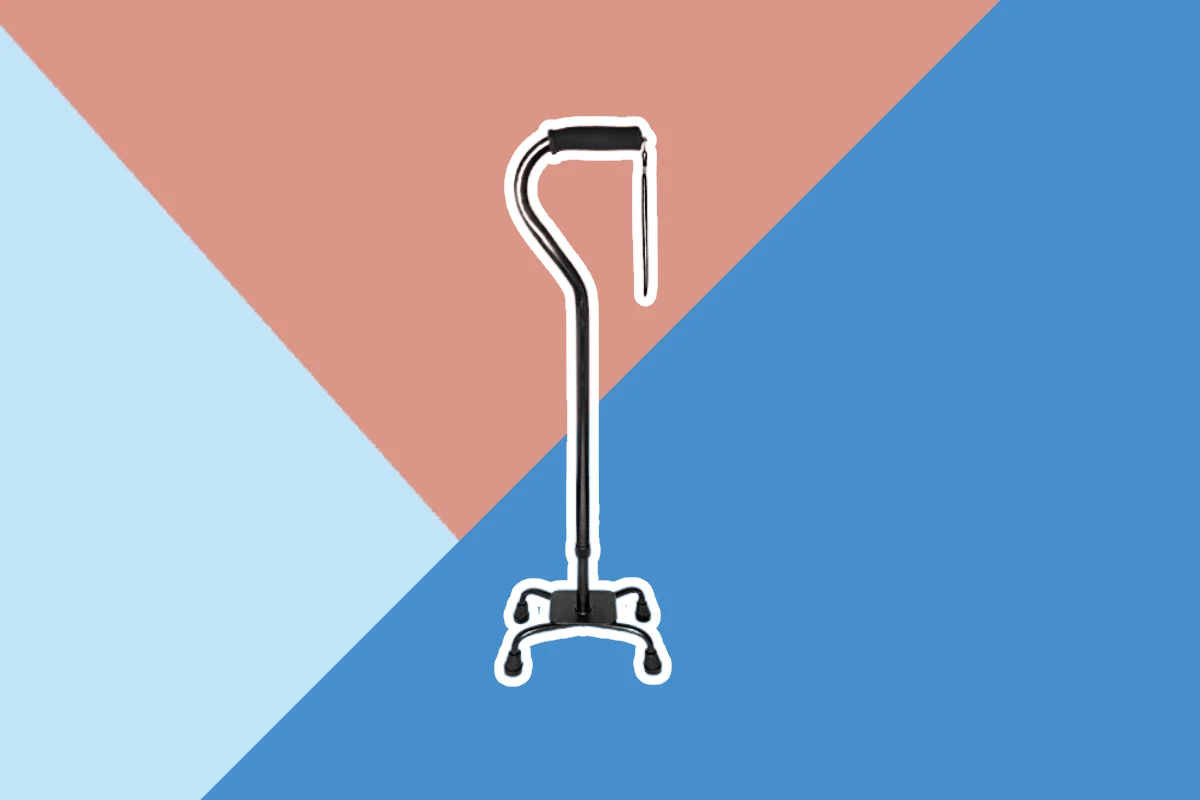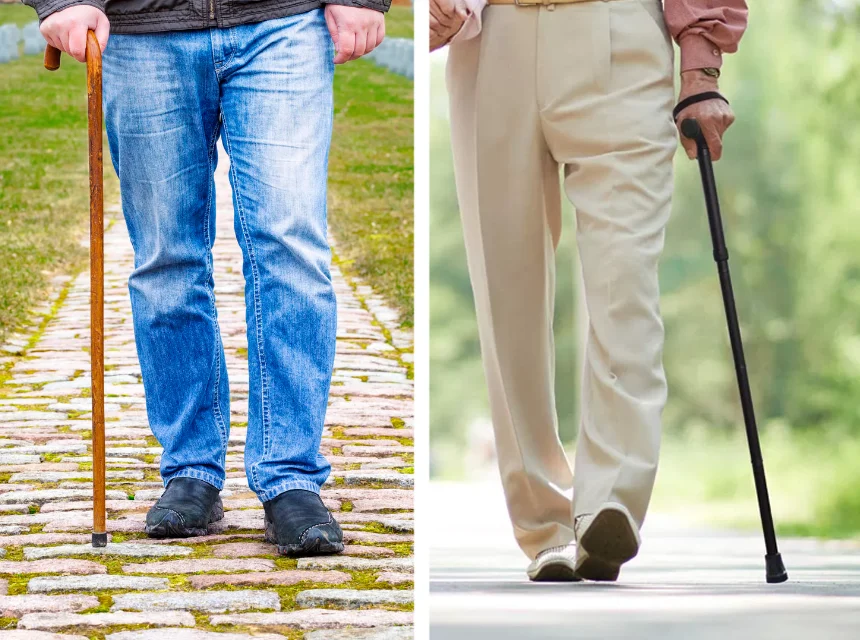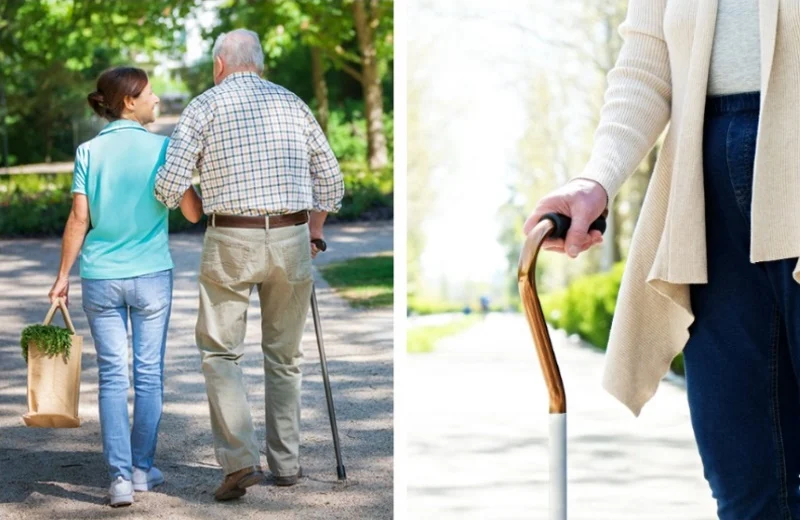Using a cane properly is crucial. Read the article below to make sure you have the proper cane and the proper knowledge for walking with your cane.
By Nan J.Corbo | ✅ Reviewed by Ray Butcher |
SeniorFitness is reader-supported. We may earn a commission through products purchased using links on this page. Learn more about our process here
Canes are a fantastic tool for mobility. For it to function properly and supply the support and healing you need, you need to use it properly. Learning how to use a cane properly is important for every cane user to know. It helps to lessen stress and stiffness on your joints as well as improve stability and safety. No matter the reason that you require a cane. It could be because of knee surgery, a sports injury, tendonitis, heightened falling risks, balance concerns, and so much more. There are several reasons why a cane could benefit daily life. Make sure that it’s as beneficial as possible by using it correctly. Not only is there a correct way to use a cane, but also the correct type of cane, depending on your needs. Read below for our in-depth advice on both of these topics. If you have any questions or comments, don’t hesitate to reach out to us.
Choosing the Correct Cane for Your Health
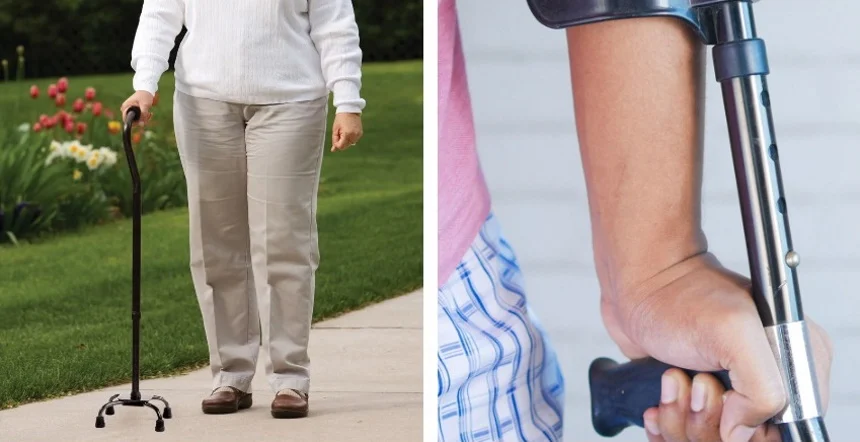
There’s a range of industry-leading brands that offer safety features and ergonomic additions: HealthSmart, RMS, Medical King, Drive Medical, Nova, Ispuoocti, and Carex. With so many different options, it can be difficult to find the right one for you.
With the market in healthcare expanding and growing with the vast wealth of knowledge and research, there are always several options to choose from. This provides wonderful personalized care for each patient as best as they can. A report from the Physical Therapy-1 and Rehabilitation Journal showed that less than 5% of Canadians use mobility aids. Approximately 1,125,000 individuals, or 4.1% of the Canadian population, use a walking aid such as a walker, crutches, a walking stick, or a cane. There’s so much to choose from. This means the choices can be overwhelming. It can be difficult to know how to find the perfect cane for you.
Types of Canes
When looking for a cane, there are a few standard types of canes. Some of the potential options include quad canes, forearm canes, and adjustable canes. Each of these comes with its benefits. Consult your physiotherapist or doctor to discuss options when it comes to a cane. Keep in mind your required grip, shaft, and cap or ferrule. These will be important to maximize your comfort and personal choice. Take the BeneCane Walking Cane, for example. This adjustable cane comes with an offset soft cushioned handle that’s lightweight and comfortable. The base adds extra stability to avoid falls, slips, and further injuring yourself. Altogether this is one cane that maximizes comfort and safety for everyone that needs it.
What’s the Proper Length for a Cane?
This is a principal factor for anyone using a cane. This length needs to be adjusted for your height. Too high, and the cane won’t be supporting you. Make the cane too short, and you’ll have to deal with the resulting back and shoulder pain and worsening posture. None of those are incredibly fun to deal with. Avoid them from the start by getting a properly measured cane. Measure yourself and the cane before purchasing any new canes. A beneficial aspect to look for would be adjustable canes. This way, you can adjust day by day if there are any changes.
To measure yourself and your new cane, start by wearing your regular footwear or shoes. Stand upright with your arms relaxed. Start with a cane about the height of your elbow when your hands are at your side. This is a great starting point that you can adjust as you go. To get a better and more precise measurement. Bend your elbow at a comfortable angle, approximately 15 degrees to 25 degrees. Maintain the position and comfort level as if you were using the cane to steady yourself. The distance between your wrist and the ground is how high your cane should be.
Proper Way to Use a Cane
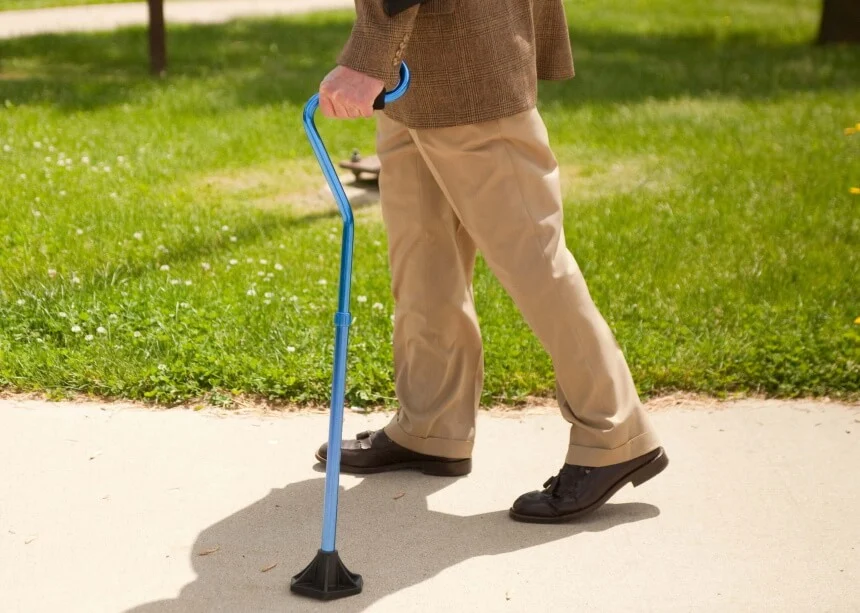
Using a cane properly is a vital part of the healing process. There’s a lot of good that a cane can do.
A cane is a tool that’s supposed to help with walking, balance, pain management, stress, and physical exertion. Canes, along with other mobility aids, have become more and more popular. A study out of the University of Vermont found that the use of walking aids and other mobility aids has increased by 50% in the past ten years – 2 . The authors consider this trend to continue in future decades.
If a cane is used improperly, it can cause much more damage than not using it. Several models aim to make your experience the best it can be. One example is the StrongArm Comfort Cane. This Self Standing Lightweight Adjustable Walking Cane comes with a Stabilizing Wrist support and Provides Extra Support & Stability. With an Ergonomic Forearm Grip, safety and security are the primary priority.
How to Walk with a Cane Properly?
When it comes to the specifics of when, why, and for how long you use a cane – 3 , that’s individual to each person. Those specifics are best left to your doctor. The best way to walk with a cane is by following these simple steps.
1. Place Your Cane on The Proper Side
Make sure that you support the ‘bad’ foot by having the cane on the same side as the “Good” leg. This is to ensure adequate support and balance when you step forward.
2. Position Your Cane Properly
Keep your cane slightly to the side of your body and about two inches forward. That’s an approximation. Start there and then adjust for your comfort and stability.
3. Start Walking Forward
Now it’s time to walk. When you go to put your “bad” leg forward, move you can at the same time. Keep the cane steady and firmly planted on the ground while you walk forward with your uninjured or “Good” leg.
4. Practice Makes Perfect
When you’re first starting, get someone to supervise you while you get comfortable and confident using your new crutch. You’ll have the hang of it in no time!
How to Walk Up the Stairs Using a Cane?
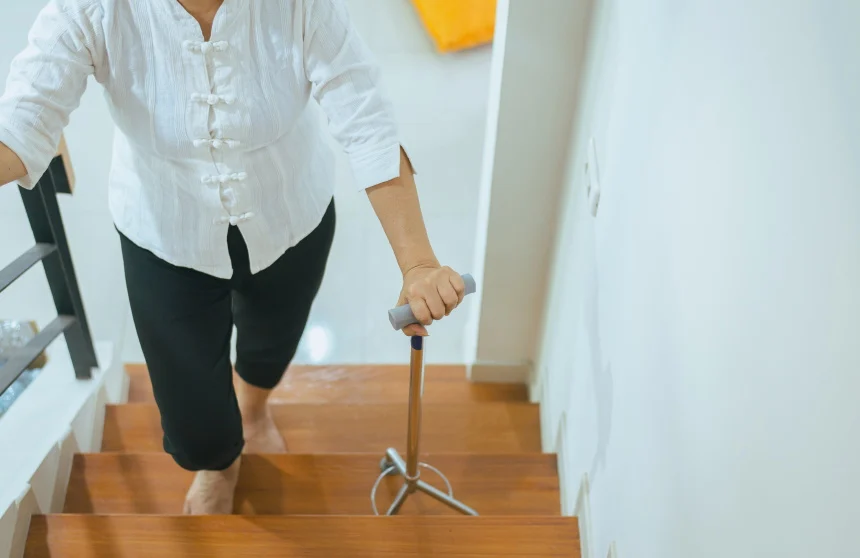
If there isn’t a handrail, keep your cane on your “good” side. When you take a step forward, start with your “good” leg. Then place your cane on the same step while transferring your “bad” leg to the next step.
Walking up the stairs with a cane can seem overwhelming. It’s like an entirely new appendage to maneuver. It may take a few times to get into the rhythm but make sure to take it slow. Walking upstairs is a bit different when using a cane. If there is a handrail, use that in place of your cane. Put your cane in the opposite hand. Take a step forward with the “good” leg. Then bring the “bad” foot up onto the same step.
Which Side Do You Put the Cane On?
Unlike crutches that support both sides equally, a cane only fully supports one side. Choosing which side the cane is on makes a huge difference. The biggest tip of all is to use your cane on the side that’s not in pain or injured. The cane goes on the “good” side. Then move your cane forward in unison with the injured or “bad” leg. This allows you to steady yourself while you walk.
Common Mistakes to Avoid
Mistakes happen but let’s avoid them if we can. Follow these tips in the paragraph below to have a smooth and healthy experience with your mobility aid. If you have more tips that you’ve found, please add them to the comments below!
Buy vitamins and supplements
- Use the right height of the cane.
- Make sure you’re aware of whether you need a cane or a walking stick.
- Don’t look down or look at the cane. Look straight ahead.
- Make sure to test it out for your preference and comfort.
- Always hold your cane on the opposite side of your pain or injury.
- Don’t use a cane excessively, as it can cause upper back and wrist pain.
- Be careful walking on uneven or steep terrain.
Always Consult Your Doctor
Remember, this article doesn’t replace the advice of your general practitioner or local doctor. Please reach out to medical professionals for their advice on starting or adjusting the use of a cane. There are numerous reasons that a person like yourself would benefit from using a cane. Follow up with your doctor about the proper maintenance and healing required for your health.
How to Use a Cane with a Bad Knee?
Many folks will use a cane for bad knees. Whether that’s due to [list of knee injuries], a cane will assist in mobility and independence. Canes are very common for those that are healing from knee surgery. After knee surgery, doctors request that patients stay active and moving while healing. A cane provides extra stability when they’re getting active exercise.
How to Use a Cane for Balance?

Make sure to get a cane with a rubber tip on the bottom to make sure there isn’t a risk of slipping. As a tip, buy an extra one just in case the first one falls off or loses its traction.
Using a cane for balance is quite common. This is common for folks with stroke symptoms – 4 , vertigo, dizzy spells, spastic cerebral palsy – 5 or recently given birth. For any reason that balance is compromised, a cane can be helpful to avoid any falls or further injury. A cane is just one example of a mobility aid that can improve the overall quality of life for a patient. Preventing falls is a fantastic addition to supportive shoes and nonslip socks.
Concluding Thoughts
Canes, like many other mobility aids, can help with a range of various aspects. A proper cane can help someone with their balance, pain management, joint stress, injury rehabilitation, physical exhaustion, and so much more. There are many reasons that someone could be using a cane, but for all of those cases, they must have a proper cane that’s being used properly. However, it needs to be the proper size for the patient and used correctly.
To summarize the content above, make sure you remember to have your cane on your good side, keep your cane planted on the ground, and make sure to keep an eye on where you’re going. Those are some of the top takeaways from this article. Now that you know the basics of how to use a cane properly put this information to good use. Take the advice in this article for the best usage of your cane. Take the first step to taking safer steps.
References
- Walking Aid Use in Canada: Prevalence and Demographic Characteristics Among Community-Dwelling Users | Physical Therapy | Oxford Academic – Mobility limitations represent the third most prevalent cause of disability, affecting more than 1.9 million community-dwelling Canadians.
2. Friend or foe? Study examines seniors’ increasing use of walking aids — ScienceDaily – America’s population of senior citizens is growing, and with it, a reliance on canes, wheelchairs and scooters. This proliferation of senior mobility devices is surprising considering that prior research showed a correlation between device use and falling — the leading cause of death resulting from injury among adults 65 and older.
3. A comparison of mobility assistive devices for elderly and patients with lower limb injury: Narrative Review – Older adults, people with chronic conditions, the disabled, and people with mobility impairments suffer from movement difficulties and have the risk of falling.
4. When might a cane be necessary for walking following a stroke? – PubMed – This study suggests that patients who do not load more than 40% of their body weight on their paretic lower limb may benefit from the prescription of a cane.
5. Effects of cane use on walking parameters and lower limb muscle activity in
adults with spastic cerebral palsy: a cross-sectional study – PMC – Adults with cerebral palsy often use a cane as a walking aid because of their decreased gait ability. However, it is unclear whether this affects lower limb muscle activity during walking.
www.ncbi.nlm.nih.govy Paragraph


